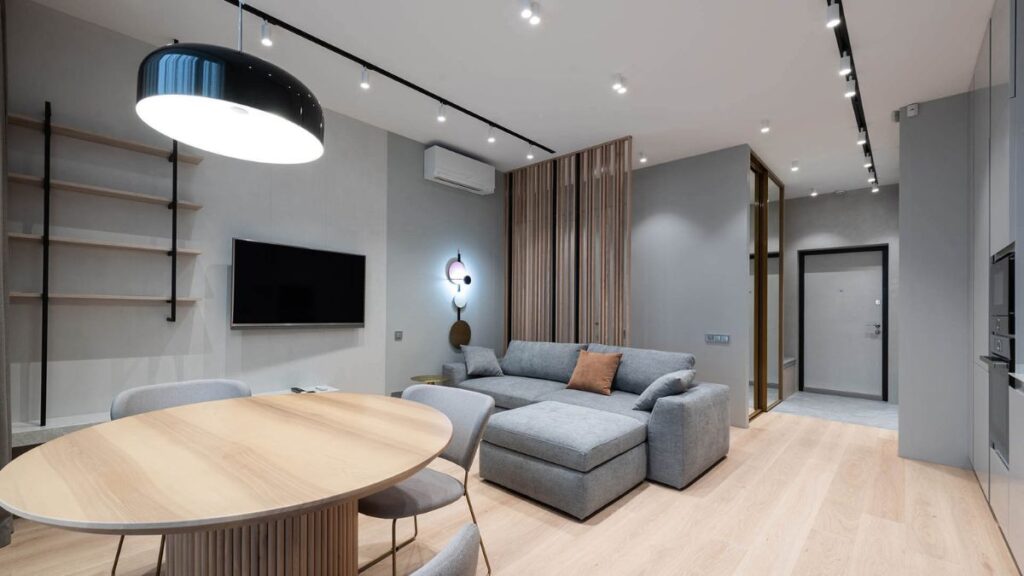Home renovations are no longer just cosmetic updates—they’re about transforming how we live, work, and connect with our spaces. The pandemic turned homes into multi-functional hubs, sparking creative approaches that blend functionality with personal expression. From smart tech to sustainable materials, it’s time to reimagine your space to fit your unique lifestyle.
Open-Concept Living: Breaking Down Barriers
Open-concept layouts continue to dominate renovation projects because they address fundamental challenges of modern living. By removing walls between kitchens, dining rooms, and living areas, you create a sense of spaciousness that makes even modest homes feel expansive.
The beauty of open-concept design lies in its flexibility. A single large space can function as a formal dining area during dinner parties, transform into a workspace during the day, and become a family entertainment zone in the evenings. This versatility proves especially valuable for families with changing needs or those who frequently entertain guests.
Creating Defined Zones Within Open Spaces
While open-concept living eliminates physical barriers, successful designs still require subtle separation between functional areas. Consider using furniture placement to create natural boundaries. A strategically positioned sofa can separate the living area from the dining space without blocking sight lines or natural light flow.
Different flooring materials or ceiling treatments can also define zones while maintaining the open feel. Area rugs, lighting fixtures, and color schemes serve as visual cues that help organize the space without compromising its openness.
Smart Home Integration: Technology That Enhances Daily Life
Smart home technology has matured beyond novelty gadgets into practical tools that genuinely improve daily living. The key to successful smart home integration lies in selecting technologies that solve real problems rather than adding complexity.
Start with fundamental systems that impact your daily routine. Smart thermostats learn your schedule and preferences, automatically adjusting temperature for comfort and energy efficiency. Automated lighting systems can simulate natural daylight patterns, supporting your circadian rhythm while reducing energy consumption.
Security and Convenience Combined
Modern smart home systems excel at combining security with convenience. Smart locks eliminate the need for physical keys while providing detailed access logs. Video doorbells allow you to screen visitors remotely, whether you’re upstairs, at work, or traveling.
Voice-activated assistants can control multiple systems simultaneously, allowing you to adjust lighting, temperature, and music with simple commands. These integrations prove particularly valuable for individuals with mobility challenges or busy families managing multiple schedules.
Sustainable Materials: Building for the Future
Sustainability has moved from a trendy option to a practical necessity in renovation projects. Sustainable materials often prove more durable and cost-effective over time while reducing environmental impact and improving indoor air quality.
Reclaimed wood offers character and history that new materials cannot match. Salvaged barn wood, industrial timber, and repurposed architectural elements bring unique textures and stories into your renovation. These materials have already proven their durability over decades or centuries.
Eco-Friendly Flooring Solutions
Flooring choices significantly impact both aesthetics and environmental footprint. Hardwood flooring, like those available in Salt Lake City, remains a classic choice, particularly when sourced from sustainably managed forests with proper certifications. Engineered hardwood options use less solid wood while providing a similar appearance and durability.
Maximizing Natural Light: Illuminating Your Space
Natural light transforms spaces in ways that artificial lighting cannot replicate. Maximizing daylight reduces energy costs, improves mood, and makes spaces appear larger and more inviting. Strategic approaches to light optimization can dramatically enhance your renovation results.
Consider enlarging existing windows or adding new ones where structurally feasible. Skylights bring light into interior spaces that cannot access exterior walls. Modern skylight designs include remote-controlled options and automated rain sensors for practical operation.
Reflective Surfaces and Light Distribution
Interior design choices significantly impact how natural light moves through your space. Light-colored walls and ceilings reflect daylight deeper into rooms. Strategically placed mirrors can redirect light into darker corners or adjacent spaces.
Glass doors between rooms allow light to flow while maintaining separation when needed. Frosted or textured glass provides privacy while still permitting light transmission. These solutions prove particularly effective in bathrooms, home offices, or bedrooms that need both light and privacy.
Personalized Touches: Making Your House a Home
The most successful renovations balance popular design trends with personal expression. Your home should tell your story through carefully chosen details that reflect your interests, travels, and lifestyle preferences.
Built-in storage solutions can showcase collections while maintaining organization. Custom shelving displays books, artwork, or treasured objects while eliminating clutter. Window seats create cozy reading nooks while providing hidden storage beneath.
Incorporating Personal History
Family photographs, inherited furniture, and meaningful artwork transform generic spaces into personal sanctuaries. Consider creating gallery walls that can evolve, mixing family photos with artwork and travel souvenirs.
Repurposing family heirlooms gives them new life while maintaining emotional connections. Grandmother’s dining table might become a kitchen island, or vintage doors could serve as headboards or room dividers. These personal touches create conversation pieces while honoring family history.
Frequently Asked Questions
How much should I budget for a major renovation?
Renovation costs vary dramatically based on scope, location, and material choices. As a general guideline, budget 10-20% more than initial estimates to account for unexpected discoveries during construction. Kitchen and bathroom renovations typically offer the best return on investment.
Should I renovate all at once or in phases?
Phased renovations allow you to spread costs over time and live in your home during construction. However, completing related work simultaneously often proves more cost-effective since contractors are already on-site. Consider your budget, timeline, and tolerance for construction disruption when making this decision.
How do I ensure my renovation adds value to my home?
Focus on improvements that appeal to broad audiences rather than highly personal choices. Kitchen and bathroom updates, improved energy efficiency, and enhanced curb appeal typically provide strong returns. Avoid over-improving for your neighborhood or making changes that cannot be easily reversed.
Conclusion
Start your renovation by focusing on what suits your lifestyle and priorities. Whether it’s smart home integration, sustainable materials, or maximizing natural light, every improvement moves you closer to your ideal space. Thoughtful planning and consulting with design professionals can ensure a successful project that enhances daily comfort, long-term satisfaction, and property value.






